Madagascar and Japan--The Resonance of Traditional Musical Instruments
Masakazu Kitanaka
Traditional folk music critic
Zamba, whose real name is Jean-Baptiste Andrianarimanana, is a Malagasy singer, composer, player, and scholar of the string instrument called the valiha. He spent 15 days in Japan around the end of July, meeting various traditional music players and instrument makers around Japan and conducting workshops for students; he was also kind enough to grant us an interview.
Playing the valiha outside on nights with a full moon
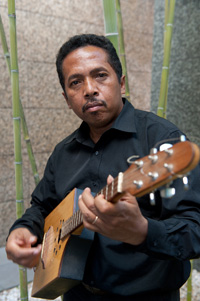 KITANAKA: Zamba, you play various traditional instruments of Madagascar, and one of the most important is the national instrument, the valiha. It's very beautiful both to look at and to hear, but since it isn't very well known to people in Japan, could you tell us a little bit about it?
KITANAKA: Zamba, you play various traditional instruments of Madagascar, and one of the most important is the national instrument, the valiha. It's very beautiful both to look at and to hear, but since it isn't very well known to people in Japan, could you tell us a little bit about it?
ZAMBA: The valiha has a sound box that is made of a long bamboo stem. In the old days, the strings were also made of bamboo skin, but now they're made of metal. The strings are fixed along the sound box and propped up with small bridges that allow you to adjust and tune the sound. Larger valihas are carried with a strap over the shoulder, and the smaller ones can be tucked under your arm. You basically hold it out in front of you and use the fingers of both hands to play it.
KITANAKA: The bamboo strings give a distinct, soft sound, and the metal strings sound almost like a harp, with clear high tones. Is that an electric valiha you're holding right now?
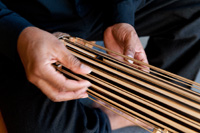 ZAMBA: Yes, this is an electro acoustic valiha. I'd played at various large festivals, and the stage microphones weren't able to pick up the sound of my valiha. So I had a talk with the engineers and we decided to attach a pick-up microphone to the instrument. The purpose isn't to change the texture of the sound, but to make sure it is amplified. This one is called a chromatic valiha. The traditional valiha can only play the pentatonic scale, but this one has been modified to handle chromatic scales too.
ZAMBA: Yes, this is an electro acoustic valiha. I'd played at various large festivals, and the stage microphones weren't able to pick up the sound of my valiha. So I had a talk with the engineers and we decided to attach a pick-up microphone to the instrument. The purpose isn't to change the texture of the sound, but to make sure it is amplified. This one is called a chromatic valiha. The traditional valiha can only play the pentatonic scale, but this one has been modified to handle chromatic scales too.
KITANAKA: How long have people been playing the valiha?
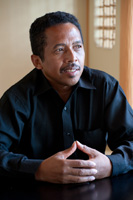 ZAMBA: There are many stories about the history of the valiha, but according to oral tradition, it is said to have descended from an instrument called the "vadi" that was brought to Madagascar around the year 1600 by Indonesian or Malaysian merchants. It seems the Malagasy then modified it to suit Madagascar. Since Madagascar has a lot of bamboo, people used the bamboo stems and skin for the sound box and strings. If you go to the southern parts of the country, there isn't much bamboo, so they used wood for the sound box to make a similar instrument called the marovany. In the past, the valiha only had five strings at most, but the one I have today has 19 strings.
ZAMBA: There are many stories about the history of the valiha, but according to oral tradition, it is said to have descended from an instrument called the "vadi" that was brought to Madagascar around the year 1600 by Indonesian or Malaysian merchants. It seems the Malagasy then modified it to suit Madagascar. Since Madagascar has a lot of bamboo, people used the bamboo stems and skin for the sound box and strings. If you go to the southern parts of the country, there isn't much bamboo, so they used wood for the sound box to make a similar instrument called the marovany. In the past, the valiha only had five strings at most, but the one I have today has 19 strings.
KITANAKA: When would people play this instrument?
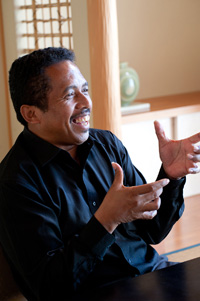 ZAMBA: In the old days, the elderly people would often play the valiha in the evening after a day of work. Children would gather and sit around the fire, and the valiha was placed towards the northeast. This was a time when there weren't any schools yet, so while listening to their elders playing the valiha, the children would also have the chance to learn from the stories they told. It's said that people often played the valiha on nights with a full moon.
ZAMBA: In the old days, the elderly people would often play the valiha in the evening after a day of work. Children would gather and sit around the fire, and the valiha was placed towards the northeast. This was a time when there weren't any schools yet, so while listening to their elders playing the valiha, the children would also have the chance to learn from the stories they told. It's said that people often played the valiha on nights with a full moon.
KITANAKA: Did the full moon have some kind of religious meaning?
ZAMBA: There was no electricity then, so I think it was easier for children to go out on bright, moonlit nights, and their parents wouldn't have to worry about them. So it's said that the valiha sounds better on nights with a full moon. I don't really know why, but those words have somehow stayed with me, and I go out and play the valiha when the moon is full too!
KITANAKA: Did they play the valiha at festivals or in front of the king?
ZAMBA: Yes. The valiha is very much a part of daily life in Madagascar, and there are records that people played the valiha at rituals worshiping ancestors or circumcision ceremonies. There's a story that when Madagascar was still under the rule of the monarchy, the British envoys had brought a hand-cranked music box as a gift for the king, and since it was a music box, it could only play the same tune over and over again. Then the king said "Let me show you a Malagasy music box," and brought out a huge box. He clapped once and it played a tune. He clapped twice and it played a different tune. The British envoys were amazed and wondered how the device worked. But it was actually only a valiha player hiding inside the box!
A natural fit with Japanese traditional instruments
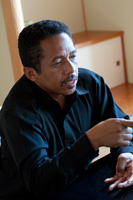 KITANAKA: During your time in Japan, you've met some musicians and makers of Japanese instruments. Could you tell us something about that?
KITANAKA: During your time in Japan, you've met some musicians and makers of Japanese instruments. Could you tell us something about that?
ZAMBA: In Osaka, I visited the shakuhachi maker Nagahiro Shinzan and shakuhachi player Nagahiro Kozan at their home. It was a traditional Japanese house, and it was a wonderful experience. There, I also met the female koto and shamisen player Michimine Ohta. I learned how the shakuhachi is made, how to play it, how it is played when accompanying the koto, and how to read music scores. They told me that when the shakuhachi and koto are played together, you need to be able to read the scores in a special way. They also said that the score would be different depending on the shakuhachi school, even for the same tune. In Kyoto, I visited the home of shinobue player Akira Morita, and he taught me part of Sakura and we played together on valiha and shinobue. I taught him a Malagasy lullaby called Mangina Zaza and we played it together. Later at his school, I learned how to play the shinobue, the methods of using tongue and breath, and how to read the score. In Kobe, I performed with Hiroshi Nakagawa, who plays the Indian flute.
KITANAKA: What did you think of playing with them?
 ZAMBA: What surprised me about playing with Japanese traditional instrumentalists is that the valiha goes extremely well with the shinobue, the shakuhachi, and the koto. This is my first time in Japan, and it was my first time playing with professional musicians on Japanese traditional instruments, but I was able to play together without any hesitation. It felt quite natural.
ZAMBA: What surprised me about playing with Japanese traditional instrumentalists is that the valiha goes extremely well with the shinobue, the shakuhachi, and the koto. This is my first time in Japan, and it was my first time playing with professional musicians on Japanese traditional instruments, but I was able to play together without any hesitation. It felt quite natural.
KITANAKA: The koto and valiha are similar in that both are played by plucking the strings on a sound box.
ZAMBA: The two have some things in common, but there are also differences. The koto uses nylon strings whereas the valiha's are metal, and the koto has a lower range than the valiha, which produces sharp high notes. They complement each other and that's why they go together so well. If we were going to make a joint composition, I think it would take some time since we would need to work out which parts should have a Japanese rhythm, a Malagasy rhythm, or a fusion of both. But I really enjoyed the short sessions that I had during my stay.
KITANAKA: What was the most memorable part of the cultural exchange for you on this trip?
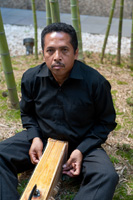 ZAMBA: Everything was memorable, but first and foremost I'm so grateful to everyone for giving me such a warm welcome as a musician. I also managed to pick up a lot of ideas about modifying instruments. That is, how to adjust and finish instruments so that they produce better sounds. Japanese techniques are especially advanced when it comes to finishing an instrument. For example, the shakuhachi has a lacquer coating on its inside, and since the valiha is also made of bamboo, I thought this could be applied to the valiha as well. I also learned a lot in terms of acoustic technology. I was also very impressed by the amazing ability of this country to recover after going through war and natural disasters. It has also managed to preserve its cultural heritage while pursuing advanced technology.
ZAMBA: Everything was memorable, but first and foremost I'm so grateful to everyone for giving me such a warm welcome as a musician. I also managed to pick up a lot of ideas about modifying instruments. That is, how to adjust and finish instruments so that they produce better sounds. Japanese techniques are especially advanced when it comes to finishing an instrument. For example, the shakuhachi has a lacquer coating on its inside, and since the valiha is also made of bamboo, I thought this could be applied to the valiha as well. I also learned a lot in terms of acoustic technology. I was also very impressed by the amazing ability of this country to recover after going through war and natural disasters. It has also managed to preserve its cultural heritage while pursuing advanced technology.
KITANAKA: I think it's wonderful that you play contemporary music while also performing traditional music on traditional instruments.
ZAMBA: Thank you very much. I hope I'll be able to collaborate with many different people as I continue my studies in the future.
(The "ha" of "valiha" is silent in Malagasy and thus the instrument is called "vali" in Madagascar, but since it is known as "valiha" in Japan, it has been referred to in this article as "valiha." In the same way, "marovany" is pronounced locally as "marovan.")
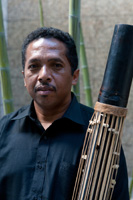 Jean-Baptiste Andrianarimanana
Jean-Baptiste Andrianarimanana
Leader of the Malagasy music group Zamba. Started his career as a singer and dancer, and then played with many artists as a valiha player, composer, and arranger. Is an active participant in various festivals in Madagascar and abroad, and has released several albums. Also studies valiha at the Conservatoire National Supérieur de Musique de Madagascar.
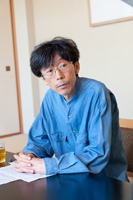 Masakazu Kitanaka, Interviewer
Masakazu Kitanaka, Interviewer
Music critic and lecturer at Tokyo College of Music. Assisted in the distribution and later became editor of NEW MUSIC MAGAZINE. Established an era of popular music criticism with others including Toyo Nakamura. Later, he became interested in world music and brought an open and passionate viewpoint to his work in introducing and reviewing world popular music. Also serves as the DJ for NHK's FM radio program World Music Time.
Related Events
Back Issues
- 2022.11. 1 Inner Diversity<3> <…
- 2022.9. 5 Report on the India-…
- 2022.6.24 The 48th Japan Found…
- 2022.6. 7 Beyond Disasters - …
- 2021.3.10 Crossing Borders, En…
- 2020.7.17 A Millennium of Japa…
- 2020.3.23 A Historian Interpre…
- 2019.11.19 Dialogue Driven by S…
- 2019.10. 2 The mediators who bu…
- 2019.6.28 A Look Back at J…

